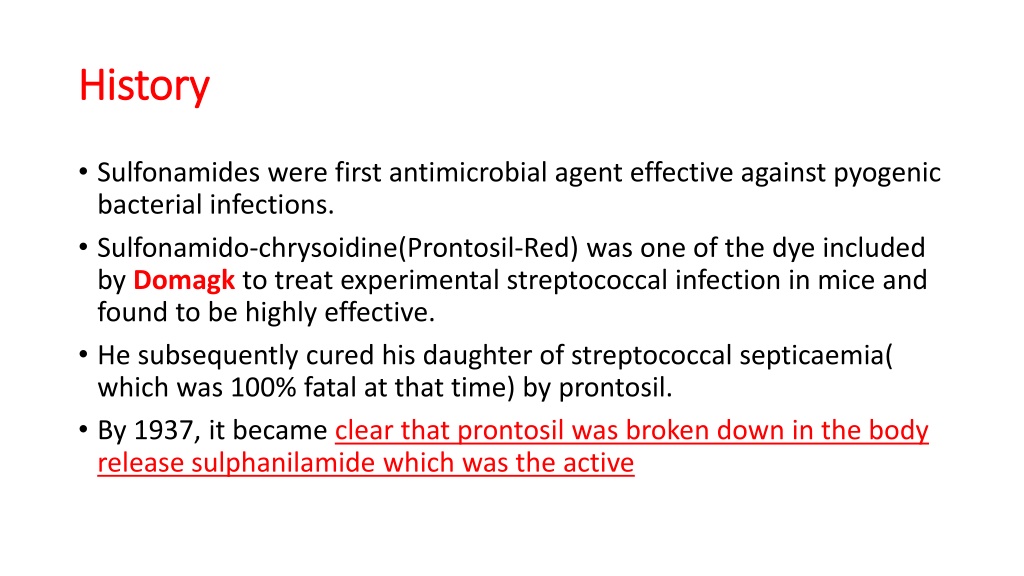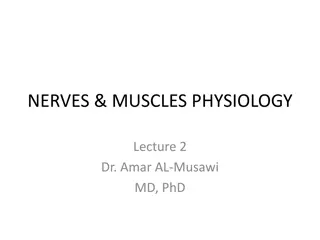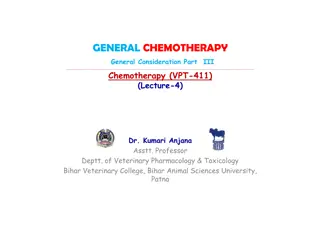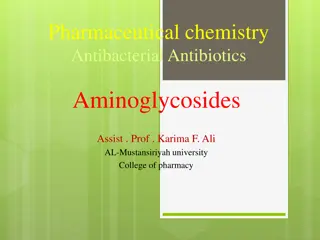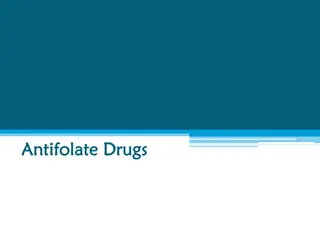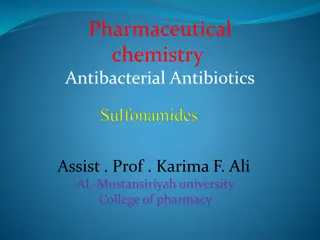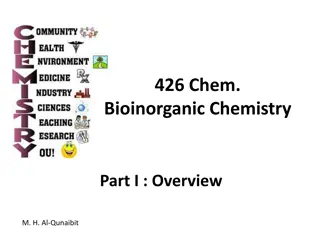Sulfonamides: History, Chemistry, and Mechanism of Action
Sulfonamides, the first effective antimicrobial agents against bacterial infections, have a rich history and chemistry rooted in sulphanilamide derivatives. Their mechanism of action involves inhibiting folic acid synthesis through competitive antagonism and sequential blocking with diaminopyrimidins like trimethoprim. This synergistic approach makes them potent against a variety of bacteria.
Download Presentation

Please find below an Image/Link to download the presentation.
The content on the website is provided AS IS for your information and personal use only. It may not be sold, licensed, or shared on other websites without obtaining consent from the author.If you encounter any issues during the download, it is possible that the publisher has removed the file from their server.
You are allowed to download the files provided on this website for personal or commercial use, subject to the condition that they are used lawfully. All files are the property of their respective owners.
The content on the website is provided AS IS for your information and personal use only. It may not be sold, licensed, or shared on other websites without obtaining consent from the author.
E N D
Presentation Transcript
History History Sulfonamides were first antimicrobial agent effective against pyogenic bacterial infections. Sulfonamido-chrysoidine(Prontosil-Red) was one of the dye included by Domagk to treat experimental streptococcal infection in mice and found to be highly effective. He subsequently cured his daughter of streptococcal septicaemia( which was 100% fatal at that time) by prontosil. By 1937, it became clear that prontosil was broken down in the body release sulphanilamide which was the active
Chemistry All sulfonamides are derivatives of sulphanilamide (para-amino benzene antibacterial component of an azo dye (prontosil). sulphonamide),the Sulphanilamide is first sulphonamide, used for its antimicrobial efficacy In the chemical structure of sufonamide there is a sulfanilamide nitrogen amino nitrogen called N4 .Most antibacterial sulfonamides have been synthesized by chemical substitution at N1 position. designated as N1and and
The individual members differs in the nature of N1 substitution, which governs the solubility ,potency and pharmacokinetic property of the compounds, A free amino group in N4 position is essential for antibacterial activity and sulfonamides have reduced antibacterial activity. generally N4 substituted However, antibacterial action within the lumen of GI tract. They are white crystalline powders, insoluble in water. certain N4 substituted sulfonamides provide Sulfonamides are weak acid.
Mechanism of action Mechanism of action Many bacteria synthesize their own folic acid for which p-amino benzoic acid (PABA) is an essential constituent. Sulfonamides are structural analogs or competitive antagonists of PABA. inhibitors of dihydropteroate Synthetase, a bacterial enzyme responsible for the union of PABA with Pteridine residue in dihydropteroic acid They are competitive bacterial formation of Which further conjugates with glutamic acid to produce dihydrofolic acid. The antagonism thus leads to inhibition of synthesis of folic acid and Subsequent metabolites leading to bacteriostatic effect. Purine and Pyrimidine synthesis Nucleic acid Synthesis
Diaminopyrimidins( Trimethoprim, ormetoprim) inhibits dihydrofolate reductase enzyme. The combination of sulphonamide and trimethoprim inhibits formation of tetrahydrofolic acid at two step. This is known as sequential blocking. This action is synergistic. Tetrahydrofolate is a coenzyme in a no of complex enzymatic reactions and also is a coenzyme in the synthesis of thymidylic acid( a nucleotide), which is a building block of DNA Trimethoprim and sulphonamide are bacteriostatic themselves, but together can be bactericidal.
Classification Classification 1. Sulfonamides used for systemic infections:- Short acting:-Highly absorbed and rapidly excreted (duration of action 4-8 hr.): Sulfathiazole, sulfamethazine (Sulfadimidine), Sulfamerazine, Sulfadiazine, and sulfapyridine. Long acting: - Highly absorbed, but slowly eliminated (duration of action 1-3 days) because of high protein binding or lipid solubility (reabsorbed in renal tubules): Sulfadoxins, Sulfamethoxypyridazine, Sulfaethoxypyridazine, Sulfadimethoxine, and Sulfachloropyridazine.
2. Sulfonamides used to treat urinary tract infections:-Sulfisoxazole (Sulfafurazole) and Sulphisomidine These are highly water soluble, rapidly excreted via urine, mostly unchanged, Undergo least acetylation or acetylated crystals are highly soluble even in acid urine (So less propensity to cause crystal Luria) and attain high concentration in urinary tract.
3. Sulfonamides used to treat gut infections (Gut-active Sulfonamides) These are poorly soluble and are not absorbed from GIT. Phthalylsulpfthiazole and Succinylsufathiazole are inactive as such and hydrolyse in the GIT by intestinal micro flora to phthalic and Succinic acid and active Sulfathiazole. Salicylazosulfapyridine (Sulfasalazine) is also hydrolysed in large intestine to Sulfapyridine and aminosalicyclic acid (anti-inflammatory agent) and is used in ulcerative Colitis in Dogs.
4. Sufonamides used topically To treat eye infection: - Sulfacetamide Sodium: As 30% Solution or 10% Ointment (highly Soluble and yield nonirritating neutral solution). To treat burn and wound infections :- Mafenide (Sulfamylon) and silver Sulfadiazine
Spectrum of activity Spectrum of activity Broad spectrum affecting gram +ve, gram-Ve, many protozoal ( coccidia, Toxoplasma spp), chlamydia. Sulfonamides have been used clinically for approximately 50 years and many organism once susceptible to the sulphonamide are now resistant To increase the activity, most of the sulphonamide used in clinical practice are combination of either trimethoprim or ormetoprim. The use of sulphonamide alone has been restricted to respiratory infection, UTI, soft tissue and intestinal infection. Susceptible organism include Arcanobacterium, Bacillus spp., E. rhusiopathiae, L. monocytogens, streptococcus spp., chlamydia spp., and protozoa (coccidia)
When less sensitive organisms are encountered, the activity can be increased with the addition of trimethoprim; Pasturella spp., Proteus spp., Salmonella spp.,Histophilus, the Protozoa Toxoplasma and coccidia. The other bacteria that may be susceptible to combination, but for which resistance can develop include Staphylococcus spp., Corynebacterium, anaerobe, Nocardia, asteroids, klebsiella, indole positive proteus, Enterobactor, E. coli and streptococcus spp. Organisms that are consistently resistant to trimethoprim sulphonamide combinations include Pseudomonas spp.,Enterococcus spp. and Bacteroids.
Interactions affecting Antimicrobial Interactions affecting Antimicrobial activity/Antagonists of activity/Antagonists of Sulfonamides Sulfonamides Compounds Containing PABA nucleus such as local anaesthetics (Procaine, butacaine and benzocaine), Procainamide and procaine penicillin. Nicotinamide, folic acid and choline and their precursors. Gelatin, albumin, peptone and serum protein (with which the Sulfa drugs bind). Antibacterial action is neutralized in the presence of pus or tissue breakdown products (contain thymidine and purines which are utilized by bacteria by passing the need of folic acid )
Pharmacokinetics Pharmacokinetics Sulfonamides are administered orally, IV (in acute cases), IM, SC, IP, intrauterine or topically. The parent Sulfonamides are administered by oral or topical route. The monosodium salts of most Sulfa drugs are given IV, but not by other parental routes (less solubility and causes severe irritation). The disodium salts can be used for IV as well as IM or SC administration (highly water soluble). Sulfonamides following oral administration are rapidly completely absorbed from the GI tract in dogs and cats, whereas ruminants taken much longer time and oral absorption in pigs and horses is intermediate. Absorption is rapid from parenteral sites
Distribution: Sulphonamides are widely distributed throughout the body and into many soft tissue including the CNS ( cerebrospinal fluid) and joints (synovial fluid) Binding to plasma protein (albumin) varies from sulphonamide to sulphonamide and from species to species and ranges from 15 -90% High protein binding affects distribution and markedly increase the half life of sulphonamide.
Metabolism Metabolism Herbivorus metabolises sulphonamide at a faster rate and more extensively than carnivores and omnivores. Acetylation of NH2 group at N4 position is a major mechanism of metabolism. Hydroxylation of methyl group at pyrimidine ring and carboxylation are also additional metabolic pathway The extent to which these metabolites are produced is drug and species dependent. Acetylation is the major pathway by which sulphonamides are metabolised in most of species. Acetylated metabolite is major urinary metabolite in cattle sheep and swine. Canine lack ability to acetylate aromatic amines, and alternative metabolic pathway are involved in metabolism of sulphonamide.
The acetylated derivatives have little antibacterial activity, but contribute to adverse effects. Most of the N4 acetylated Sulfonamides, except the sulfapyrimidine derivatives (Sulfadiazine, Sulfamerazine and Sulfadimidine) are less soluble in acidic urine, precipitate in the tubules and cause crystalluria. Excretion: Most of the Sulfonamides are excreted mainly in urine through glomerular filtration. Both renal tubular secretion and reabsorption (lipid soluble) contribute to renal excretion of sulphonamides. Lipid soluble Sulfonamides are reabsorbed in renal tubules and hence are long acting. The Crystalluria can be prevented by alkalinizing the urine, increasing water intake and reducing the dose rates or by using triple Sulfa
Adverse Effect of Sulphonamide Therapy Adverse Effect of Sulphonamide Therapy CrystallUrea Keratoconjuctivitis sicca Hypersensitivity Hepatic necrosis Hypoprothrombinemia Blood Dyscrasias Thyroid metabolism disorders Skin reaction
Renal Toxicity(crystallurea) It is characterized by Crystalluria, haematuria, and obstruction of renal tubules. The drugs crystalize in acidic urine. Crystalluria is more common with rapidly excreted sulfonamides than those excreted slowly. The renal damage is also more common with their acetylated derivatives (due to less solubility in acid urine) as compared to their glucuronide or sulfate conjugates, which are highly soluble.
Keratoconjunctivitis Keratoconjunctivitis sicca(KCS) sicca(KCS) KCS also known as Dry Eye. It is chatecterised by lack of adequate tear production resulting in ocular inflammation, irritation, Susceptibility to infection. Commonly reported in Dog treated with sulfasalazine, sulfadiazine and sulfamethoxazole.
Hypersensitivity Hypersensitivity A delayed type of hypersensitivity reaction is observed in Dog Doberman Pinschers may be more susceptible breed of Dog Reaction may be caused by either sulfadiazine, sulfadimethoxine and sulfamethoxazole. Lesions include glomerulopathy, polymyositis, polyarthritis, skin rash, skin eruptions, fever, hepatotoxicity, thrombocytopenia, neutropenia and anemia Hepatotoxicity may be caused by hypersensitivity reaction or as result of a abnormal metabolic pathway Hypoprothrombinemia have been reported in Dog, coyot pup and leghorn chicken.
Sulfaquinoxaline is unique among sulphonamide in that it can induce hypoprothrombinemia in animals within 24 hr after dosing by lengthening prothrombin times. Blood dyscrasias: Anemia and thrombocytopenia . Anemia induced by trimethoprim sulphonamide combination may be due to decreased serum folic acid level which may be due to inhibiting the folate production by intestinal bacteria. Some veterinarian administer folic acid along with sulphonamide- Teimethprim Both sulfamethoxazole and sulfadiazine have been associated with hypothyroidism in Dog. The effect is caused ability of sulphonamide to inhibit thyroid peroxidase activity.
Potentiated sulphonamide Potentiated sulphonamide
Combination of Diaminopyrimidines and Sulphonamide Diaminopyrimidins: trimethoprim, tetroxoprim. Causes sequential block of folate metabolism Combination have synergistic effect, Have more activity and bactericidal effect on bacteria and its resistant form. Diaminopyrimidins blocks Dihydrofolate reductase Trimethoprim is >50,000 times more active against bacterial DHFR than against mammalian enzyme. ormetoprim, aditoprim,
Some combination used in Veterinary Trimethoprim-Sulfadiazine Trimethoprim sufamethoxazole(cotrimoxazole) Sulfadimethoxine-ormetoprim Trimethoprim-sulphonamide are formulated in the ratio of 1:5 Optimal ratio in body should be 1:20 to produce antibacterial activity
The antibacterial spectrum of trimethoprim is smaller to Sulfonamides, It is also effective against some Sulfonamide resistant organism like S. typhi, E.coli, klebsiella, Hemophyllus etc. It is a bacteriostatic drug and and act by selectively inhibiting bacterial dihydrofolate reductase enzyme. its combination with Sulfonmides results in potentiation of antibacterial action by sequential blockade at two steps in bacterial folate metabolism in nucleic acid synthesis
Trimethoprim-Sulfadiazine: Used for respiratory infections, urinary tract infection, urogenital infe, cattlection, protozoal infection, bone and joint infection and soft tissue infection Dose(Horse, Dog; 30mg/kg bwt twice a day orally ( 5mg/kg trimethoprim +25mg/kg of sulphonamide)
